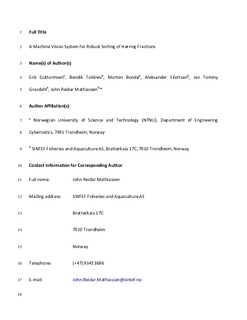| dc.contributor.author | Guttormsen, Erik | |
| dc.contributor.author | Toldnes, Bendik | |
| dc.contributor.author | Bondø, Morten Steen | |
| dc.contributor.author | Eilertsen, Aleksander | |
| dc.contributor.author | Gravdahl, Jan Tommy | |
| dc.contributor.author | Mathiassen, John Reidar Bartle | |
| dc.date.accessioned | 2017-11-29T09:44:19Z | |
| dc.date.available | 2017-11-29T09:44:19Z | |
| dc.date.created | 2016-07-19T09:14:14Z | |
| dc.date.issued | 2016-07-16 | |
| dc.identifier.citation | Food and Bioprocess Technology. 2016, 9 (11), 1893-1900. | nb_NO |
| dc.identifier.issn | 1935-5130 | |
| dc.identifier.uri | http://hdl.handle.net/11250/2468402 | |
| dc.description.abstract | Among the rest raw material in herring (Clupea harengus) fractions, produced during the filleting process of herring, there are high-value products such as roe and milt. As of today, there has been little or no major effort to process these by-products in an acceptable state, except for by manual separation and mostly mixed into low-value products. Even though pure roe and milt fractions can be sold for as much as ten times the value of the mixed fractions, the separation costs using manual techniques render this economically unsustainable. Automating this separation process could potentially give the pelagic fish industry better raw material utilization and a substantial additional income. In this paper, a robust classification approach is described, which enables separation of these by-products based on their distinct reflectance features. The analysis is conducted using data from image recordings of by-products delivered by a herring processing factory. The image data is divided into three respective classes: roe, milt, and waste (other). Classifier model tuning and analysis are done using multiclass support vector machines (SVMs). A grid search and cross-validation are applied to investigate the separation of the classes. Two-class separation was possible between milt/roe and roe/waste. However, separation of milt from waste proved to be the most difficult task, but it was shown that a grid search maximizing the precision—the true positive rate of the predictions—results in a precise SVM model that also has a high recall rate for milt versus waste. | nb_NO |
| dc.language.iso | eng | nb_NO |
| dc.relation.uri | http://link.springer.com/article/10.1007/s11947-016-1774-2 | |
| dc.rights | Navngivelse-Ikkekommersiell-DelPåSammeVilkår 4.0 Internasjonal | * |
| dc.rights.uri | http://creativecommons.org/licenses/by-nc-sa/4.0/deed.no | * |
| dc.title | A Machine Vision System for Robust Sorting of Herring Fractions | nb_NO |
| dc.type | Journal article | nb_NO |
| dc.type | Peer reviewed | nb_NO |
| dc.description.version | submittedVersion | nb_NO |
| dc.rights.holder | The authors | nb_NO |
| dc.source.pagenumber | 1893-1900 | nb_NO |
| dc.source.volume | 9 | nb_NO |
| dc.source.journal | Food and Bioprocess Technology | nb_NO |
| dc.source.issue | 11 | nb_NO |
| dc.identifier.doi | 10.1007/s11947-016-1774-2 | |
| dc.identifier.cristin | 1368523 | |
| dc.relation.project | Norges forskningsråd: 219204 | nb_NO |
| cristin.unitcode | 7566,5,0,0 | |
| cristin.unitname | Prosessteknologi | |
| cristin.ispublished | true | |
| cristin.fulltext | preprint | |
| cristin.qualitycode | 1 | |

